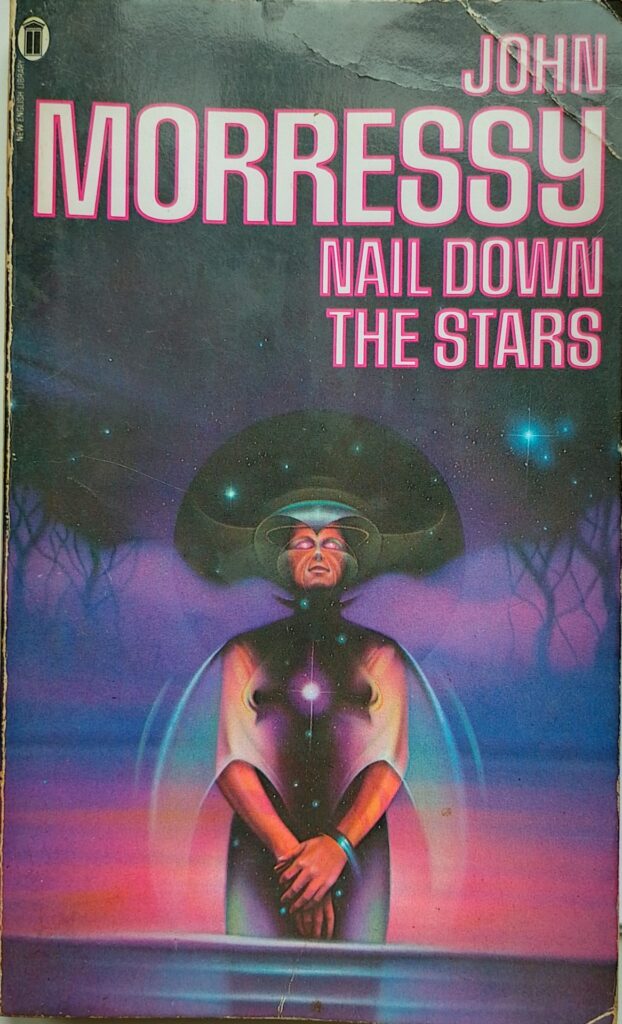First published 1973. New English Library paperback, 1979, pp204, c.75,000 words.
This book follows the same formular and is set in the same universe as Morressy’s Starbrat. Indeed the main protagonists from the two books meet and travel together briefly in one episode of this story, although there is no overt recognition; just one of many encounters between travellers. Like Starbrat, the story here could have been set in ancient Europe, in this case a medieval world of travelling entertainers, court jesters and musicians. It is a similar picaresque tale of a child, plucked from his home, and set loose to find himself as he journeys between planets: a tale broken into episodes like Gulliver’s Travels.
Here, our hero starts out as Jolon Gallamor whose father has offended some power and been murdered for it. The son has to flee. On escaping, he joins a travelling circus (yawn) and becomes a ‘skillsman’, i.e. someone skilled in the circus, musician’s and magician’s arts. Initially he his young and naïve and exploited by those who’s dreams are bigger than their bank balances. However he is a bright lad, becomes a master of the skills and manages to escape just in time. He is searching for peace from pursuit, but it is hard to find. Somehow much of the technology of Old Earth has been lost. The current inhabitants of the galaxy are still able to use the fast-than-light spacecraft of Old Earth, but the only weapons they have are pistols and swords.
Along the way, he frequently changes his name in order to escape pursuit. This leads to some amusing episodes where, having read Shakespeare’s plays in a book from ‘Old Earth’, he takes on the name of Will and starts to re-write the plays, discovering on the way that, however peaceful the people, the more murders the better. ‘…one about an unfortunate Moor and another about a Scottish regicide, he put together as The Downfall of Moran’ [p55]. Another joke is made of Finnegan’s Wake: ‘It could be a book of prophesies as anything else. It’s beyond me’ [p32] says a character called Prospero.
Morressy is an able writer, making for easy reading, although his style is unsophisticated: more panto than high art. He invents some interestingly weird habitable planets. Some are paradise and some hell, some lush and some almost all desert. On some the people live in peace and harmony – at least until the pirates and slavers come to call – and on others cruel tyrants reign. Paradise has its infantile downside. While the protagonist is supposedly a peaceful ‘skillsman’, he somehow finds himself in the heart of plenty of battles – considerable blood is spilt. Much of the fighting is pointless and done for the sake of all important (to some races) honour. Occasionally Morressy delivers a telling word e.g. ‘Beliefs were walls of straw erected against a roaring wind that levelled forests.’ [p80]. The motto of the protagonist might be: ‘That was the sensible way to look at it; not to rant and curse, but to make the best of a situation.’ [p115], and that often means skipping town fast when the opportunity arises.
If there is a theme to all this traveller’s tales’ stuff then it is an exploration of the love of the struggle to be top-dog, as displayed in a love of fighting to achieve honour. It is mostly a macho galaxy. Women are all secondary characters, even if they are queens and intelligent. They stay at home and have the children while the men go out to farm or fight and dream of returning home. It asks the eternal question of how can we live in peace if others know we are weak?
While this is classified as science fiction, there is no science here. It is fantasy. As such it is entertainingly inventive.
Wikipedia biography of Morressy: https://en.wikipedia.org/wiki/John_Morressy
Others’ reviews of the book: https://www.goodreads.com/book/show/1975338.Nail_Down_the_Stars?from_search=true&from_srp=true&qid=GBng15liD4&rank=1
© William John Graham, November 2023

